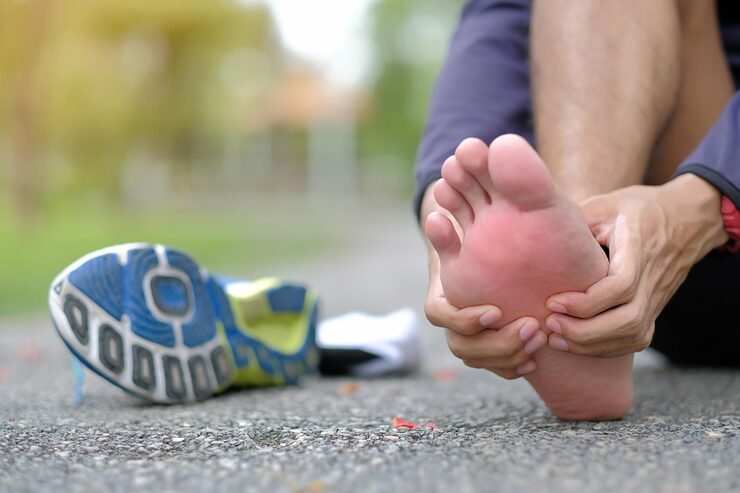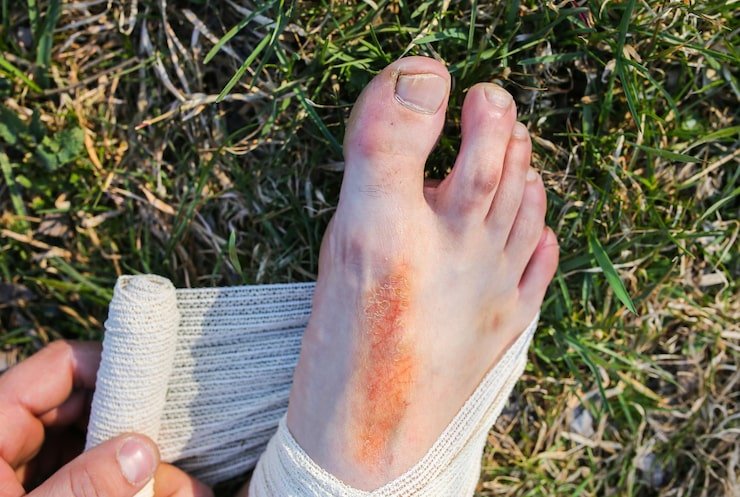You tripped over a rug, stubbed your foot on the bedpost, or maybe dropped a dumbbell and now your pinky toe is the size and color of a plum. You heard a snap, but your first question isn’t, Is it serious? it’s When can I run again?
It’s a familiar panic for any runner or fitness enthusiast.
Let’s deliver the immediate, expert answer: No, you absolutely should not run with a broken pinky toe.
Attempting to run before your toe is properly healed risks turning a relatively simple fracture into a displaced break requiring surgery, or worse, chronic pain that sidelines you for six months instead of six weeks. Your patience now determines your pain later.
This guide will walk you through the medical reality, the mandatory 6-week healing timeline, and the only safe way to return to running.

The Medical Reality: Why Running is a Bad Idea
While the pinky toe (or the fifth metatarsal) might seem insignificant, it plays a vital role in your running gait:
- It helps maintain your balance and stability.
- It is critical for the final push-off phase as your foot leaves the ground.
Every time you run, the impact forces passing through your foot are three to four times your body weight. Sending that force through a broken, unhealed bone is catastrophic for the recovery process.
The Consequences of Running on a Fracture
Ignoring the pain and running anyway doesn’t make you tough; it makes you prone to lifelong issues:
- Delayed Healing: The constant pressure prevents the bone ends from knitting together.
- Displacement: The fracture pieces can shift (become displaced), which immediately increases the likelihood of needing surgery to put the bone back in place.
- Chronic Pain & Arthritis: Long-term damage to the joint and surrounding cartilage can lead to arthritis and persistent stiffness.
- Compensation Injuries: You will instinctively shift your weight to your other foot, leading to high-risk stress fractures in the healthy foot, ankle, or knee pain.
Diagnosis and First Aid: What to Do Right Now The 48-Hour Rule
Before you worry about running, you need to confirm the severity and stabilize the injury.
How to Know It’s Broken (Go See a Doctor If):
- You heard a snap or a pop at the time of injury.
- The toe looks deformed or is pointing at an unnatural angle.
- You have numbness or a loss of feeling in the toe.
- You are unable to bear any weight on the foot without searing pain.
Immediate R.I.C.E. Protocol (The First 8 Hours)
If you can’t get to the doctor immediately, follow this protocol:
- Rest: Absolutely no running, no jogging, no walking without protective footwear.
- Ice: Apply an ice pack (wrapped in a thin towel) for 5-20 minutes every hour to reduce swelling.
- Compression (Buddy Taping): Gently tape the broken pinky toe to the adjacent fourth toe using medical tape, placing a small piece of cotton or gauze between the two to prevent skin rubbing. This acts as a splint.
- Elevation: Keep your foot elevated above the level of your heart as much as possible to minimize swelling.
The Healing Timeline: When Can I REALLY Run?
A simple, non-displaced fracture of the pinky toe requires patience. The timeline below is a general guide; your doctor’s X-ray clearance is the only guarantee.
Typical Healing Window for a Simple Pinky Toe Fracture
| Phase | Duration | Protocol & Activity Level |
| Initial Stabilization | Week 1 to 2 | Maximum rest, R.I.C.E. Non-weight bearing (crutches) or restricted walking in a stiff-soled shoe/boot. |
| Bone Consolidation | Week 3 to 6 | Weight bearing allowed in protective footwear. Pain should be minimal. No running or jumping. |
| Physical Clearance | Week 6 and Beyond | X-ray confirmed healing. Doctor grants clearance to begin functional rehabilitation. |
The average time before a runner can begin a modified running program is typically 6 to 8 weeks.

Safe Cross-Training During Recovery (Don’t Lose Your Fitness)
A broken toe is not a broken body. You can maintain your cardio fitness and sanity through low-impact cross-training.
Safe Activities (Zero Impact):
- Swimming: Excellent for full-body cardio. Just ensure you do not push off the wall with your injured foot. Focus on smooth glides and gentle flutter kicks.
- Upper-Body Weight Training: Focus on seated exercises (shoulder press, bench press, rows) and standing work that doesn’t require complex foot stability (like bicep curls).
- Cycling (Spin/Bike): If you can pedal absolutely pain-free with the toe completely immobile in a stiff shoe, this can be an option. Stop immediately if you feel pressure.
- Water Running/Aerobics: Using a flotation belt to run in the deep end of a pool allows you to mimic the running motion without impact.
Unsafe Activities (High Risk):
Avoid all high-impact and dynamic activities until medically cleared, including running, jumping, sprinting, plyometrics, and aggressive jumping rope.
The Return-to-Running Protocol (Preventing Re-Injury)
Getting back on the road requires discipline. The bone may be healed, but the muscles and tendons around it are weak.
The 10% Rule for Comebacks
- Start with Walking: Begin with brisk walking for 20 minutes. If it’s pain-free for 3 days, move to step 2.
- Walk/Jog Intervals: Start with 1 minute of jogging followed by 4 minutes of walking. Repeat for 20 minutes.
- Increase Slowly: Never increase your weekly running distance by more than 10% to prevent re-injury or a new stress fracture.
Must Read This : Some Exercise to Do Every Day
Footwear & Pain
- Stiff-Soled Shoes: For the first few weeks back, wear shoes with a rigid sole. This helps limit the bending and flexing motion of the toe joint as you push off.
- Listen to Your Pain: A dull ache or muscle soreness is normal; a sharp, stabbing, or searing pain means STOP. You are pushing too hard, and you must rest.
Conclusion: Patience is Part of the Marathon
So, can you run with a broken pinky toe? No. And any doctor or experienced runner will tell you the same thing.
A month or two off running is frustrating, but it’s a necessary pause that saves you from six months of chronic pain or an unnecessary surgery.
Be patient. Focus on cross-training, adhere strictly to the doctor’s timeline, and give your small but mighty pinky toe the time it needs to heal completely. Your running shoes will be waiting.
FAQ
1.How long does a broken pinky toe take to heal completely?
A simple, non-displaced pinky toe fracture typically takes 4 to 6 weeks to heal enough to bear weight. However, a full return to high-impact activities like running usually requires 6 to 8 weeks minimum, and always requires a doctor’s clearance.
2.Can I bike or use the elliptical with a broken pinky toe?
Possibly, but with extreme caution. Low-impact cardio is safe only if you can perform the motion completely pain-free. You must wear a stiff-soled shoe to restrict toe movement. Stop immediately if you feel pressure or pain in the toe joint.
3. What is buddy taping, and does it help running?
Buddy taping is a first-aid technique where you gently tape the injured pinky toe to the toe next to it. It acts as a splint to stabilize the fracture. It helps healing, but it does NOT make running safe. It is strictly for support during necessary walking.
4.When can I stop wearing the protective boot or shoe?
You should only stop wearing the protective footwear (like a stiff-soled shoe or walking boot) when your doctor instructs you to, usually after the 4 to 6-week mark. Removing it too soon risks displacement and re-injury.
5. How do I know if my pinky toe is broken or just badly stubbed/sprained?
Stubbed toes often improve within a few days. If the pain is severe, you heard a pop, the toe is visually deformed, or you cannot bear weight without intense pain, assume it is broken and see a doctor for an X-ray. Never guess with a suspected fracture.


